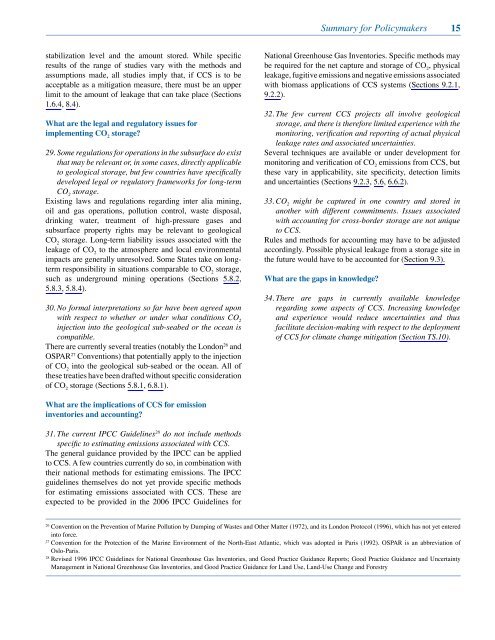carbon dioxide capture and storage carbon dioxide capture and ...
carbon dioxide capture and storage carbon dioxide capture and ...
carbon dioxide capture and storage carbon dioxide capture and ...
You also want an ePaper? Increase the reach of your titles
YUMPU automatically turns print PDFs into web optimized ePapers that Google loves.
stabilization level <strong>and</strong> the amount stored. While specific<br />
results of the range of studies vary with the methods <strong>and</strong><br />
assumptions made, all studies imply that, if CCS is to be<br />
acceptable as a mitigation measure, there must be an upper<br />
limit to the amount of leakage that can take place (Sections<br />
1.6.4, 8.4).<br />
What are the legal <strong>and</strong> regulatory issues for<br />
implementing CO <strong>storage</strong>?<br />
29. Some regulations for operations in the subsurface do exist<br />
that may be relevant or, in some cases, directly applicable<br />
to geological <strong>storage</strong>, but few countries have specifically<br />
developed legal or regulatory frameworks for long-term<br />
CO 2 <strong>storage</strong>.<br />
Existing laws <strong>and</strong> regulations regarding inter alia mining,<br />
oil <strong>and</strong> gas operations, pollution control, waste disposal,<br />
drinking water, treatment of high-pressure gases <strong>and</strong><br />
subsurface property rights may be relevant to geological<br />
CO 2 <strong>storage</strong>. Long-term liability issues associated with the<br />
leakage of CO 2 to the atmosphere <strong>and</strong> local environmental<br />
impacts are generally unresolved. Some States take on longterm<br />
responsibility in situations comparable to CO 2 <strong>storage</strong>,<br />
such as underground mining operations (Sections 5.8.2,<br />
5.8.3, 5.8.4).<br />
30. No formal interpretations so far have been agreed upon<br />
with respect to whether or under what conditions CO 2<br />
injection into the geological sub-seabed or the ocean is<br />
compatible.<br />
There are currently several treaties (notably the London 26 <strong>and</strong><br />
OSPAR 27 Conventions) that potentially apply to the injection<br />
of CO 2 into the geological sub-seabed or the ocean. All of<br />
these treaties have been drafted without specific consideration<br />
of CO 2 <strong>storage</strong> (Sections 5.8.1, 6.8.1).<br />
What are the implications of CCS for emission<br />
inventories <strong>and</strong> accounting?<br />
31. The current IPCC Guidelines 2 do not include methods<br />
specific to estimating emissions associated with CCS.<br />
The general guidance provided by the IPCC can be applied<br />
to CCS. A few countries currently do so, in combination with<br />
their national methods for estimating emissions. The IPCC<br />
guidelines themselves do not yet provide specific methods<br />
for estimating emissions associated with CCS. These are<br />
expected to be provided in the 2006 IPCC Guidelines for<br />
Summary for Policymakers<br />
National Greenhouse Gas Inventories. Specific methods may<br />
be required for the net <strong>capture</strong> <strong>and</strong> <strong>storage</strong> of CO 2 , physical<br />
leakage, fugitive emissions <strong>and</strong> negative emissions associated<br />
with biomass applications of CCS systems (Sections 9.2.1,<br />
9.2.2).<br />
32. The few current CCS projects all involve geological<br />
<strong>storage</strong>, <strong>and</strong> there is therefore limited experience with the<br />
monitoring, verification <strong>and</strong> reporting of actual physical<br />
leakage rates <strong>and</strong> associated uncertainties.<br />
Several techniques are available or under development for<br />
monitoring <strong>and</strong> verification of CO 2 emissions from CCS, but<br />
these vary in applicability, site specificity, detection limits<br />
<strong>and</strong> uncertainties (Sections 9.2.3, 5.6, 6.6.2).<br />
33. CO 2 might be <strong>capture</strong>d in one country <strong>and</strong> stored in<br />
another with different commitments. Issues associated<br />
with accounting for cross-border <strong>storage</strong> are not unique<br />
to CCS.<br />
Rules <strong>and</strong> methods for accounting may have to be adjusted<br />
accordingly. Possible physical leakage from a <strong>storage</strong> site in<br />
the future would have to be accounted for (Section 9.3).<br />
What are the gaps in knowledge?<br />
34. There are gaps in currently available knowledge<br />
regarding some aspects of CCS. Increasing knowledge<br />
<strong>and</strong> experience would reduce uncertainties <strong>and</strong> thus<br />
facilitate decision-making with respect to the deployment<br />
of CCS for climate change mitigation (Section TS.10).<br />
26 Convention on the Prevention of Marine Pollution by Dumping of Wastes <strong>and</strong> Other Matter (1972), <strong>and</strong> its London Protocol (1996), which has not yet entered<br />
into force.<br />
27 Convention for the Protection of the Marine Environment of the North-East Atlantic, which was adopted in Paris (1992). OSPAR is an abbreviation of<br />
Oslo-Paris.<br />
28 Revised 1996 IPCC Guidelines for National Greenhouse Gas Inventories, <strong>and</strong> Good Practice Guidance Reports; Good Practice Guidance <strong>and</strong> Uncertainty<br />
Management in National Greenhouse Gas Inventories, <strong>and</strong> Good Practice Guidance for L<strong>and</strong> Use, L<strong>and</strong>-Use Change <strong>and</strong> Forestry<br />
1
















